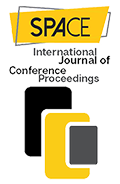The Interpretation of Environmental Ideal Images Based on Ji Chang Garden’s Literary Texts
DOI:
https://doi.org/10.51596/sijocp.v3i1.59Keywords:
texts of Jichang Garden, Ideal-images, architecture drawings, Structure Analysis, Hermeneutic PhenomenologyAbstract
The creation of literary texts on traditional Chinese gardening was a cultural phenomenon among literati and officialdom; the fictional imagination and personal experience of the garden owner and other literati constructed the ideal images of the traditional Chinese garden environment together with the physical space. Therefore, garden literary texts become a mirror of the built environment that extends it into an idealised space-time through literary rhetoric such as metaphor and metonymy, an important medium for us to interpret the connotations of Environmental Ideal Images that combine physical space and fictional imagination.
We take the Jichang Garden as the research object, the typical Chinese garden during the Ming Dynasty (1368-1644). By applying the methods of Linguistic Structural Analysis and Hermeneutic Phenomenology, we excavate the space-time hiding in texts and visualise the environmental ideal image inside literature through drawing methods such as diagrams, collages, plans and axonometry. We intervene in the texts as interpreters from the perspective of art and philosophy, question and break through the cognition of regarding the built environment as all of gardening, and ultimately reconstruct the overall Environmental Ideal Images of Jichang Garden that combines the physical space and fictional imagination. Through the research, we have found that the fictional ideal images created by literati involve specific activities in the present and collective memories of the past, which reveal the potential and attractive side of Chinese traditional gardens.
References
Bois, Y. A. (1981). Metamorphosis of Axonometry. Journal of Daidalos, 1, 41-58.
Cheng, F. (2016). Chinese Poetic Writing. Hong Kong: The Chinese University of Hong Kong Press.
Liang, W. (2013). The Soul of Place: The Ideal-images of Humble Administrator Garden in the Wen Zhengming’s Poems and Painting. The Journal of Zhuangshi, 12, 61-65.
Qin, Z. (2009). Complication of Family Qin’s Jichang Garden. Shanghai: Cishu, 29-77.
Ricoeur, P. (2007). From Text to Action: Essays in Hermeneutics. Evanston: Northwestern University Press.
Rowe, C., & Slutzky, R. (1997). Transparency. Swiss: Birkhäuser Architecture.
Wang, S. (2006). The Prose of Jingan Garden for uncle. In Y. Guanghui (Eds.), Pictures and writings of Chinese traditional gardens. (p. 124). Shanghai: Tongji University Press.
Wen, Z., & Tu, L. (2011). Superfluous Things. Hangzhou: Zhejiang Press, 132.
Published
How to Cite
Issue
Section
Categories
License
Copyright (c) 2023 Mengmiao Yu, Xiao Yang

This work is licensed under a Creative Commons Attribution 4.0 International License.













